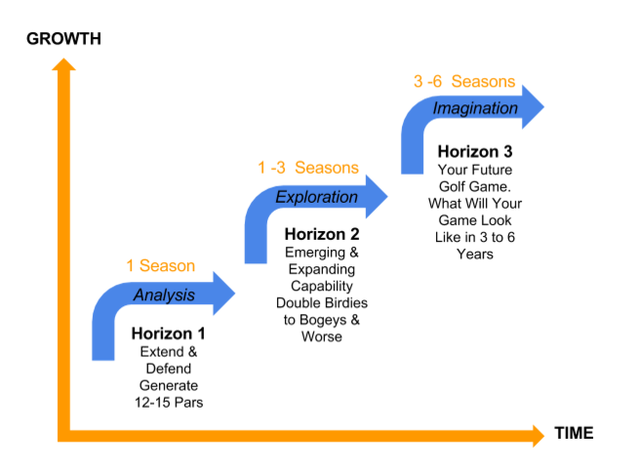 How does Rory McIlroy keep getting better? How does Rory McIlroy keep getting better? As you mature as an elite amateur or professional golfer, it’s certain that you will face a decline in improvement at some stage, as growth in your game succumbs to the inertia that comes about by trying to maintain the skills you are already well accomplished in. In other words, what has got you here, won’t get you there. You see it is inevitable that in your pursuit of excellence as an elite golfer that you will need to overcome continual performance resistance that comes from essentially being very good at your well learned and reliable skills. In-fact, you probably spend most of your available time trying to maintain them, but not nearly as much time working on your growth skills, or the types of skills that help you make continual progress. And progress in this case (especially for a tour golfer) is a lower score average over a season. For you to continue to achieve consistent levels of growth in your game throughout your career, you will need to not only focus on your core skills that keep your competitive edge sharp, but you will need to develop, manage and improve the high-payoff skills that drive your score average lower, so you can make more cuts than you miss, and generate more credits than debits. The 3 Horizons of Growth ModelIn this article I’m going to adapt some of the basic features of The Three Horizons of Growth Model (Above) featured in the book The Alchemy of Growth by Mehrdad Baghai, Stephen Coley, and David White, to provide you with a clear and simple structure you can use as a guide to assess your potential opportunities for sustained growth over the next three to six years, without neglecting your improvement in the present. Basically we are going to discuss the concepts of; 1. Par generation as your core golf process 2. The Double your Birdie's to Bogey Ratio as your emerging golf strategy 3. The importance of transformative thinking for long-term growth Using the Three Horizons of Growth approach for golf improvement, it will come to be seen as essential thinking if you are to break free of performance plateauing. You will see that it is imperative that you invest in creative and innovative practice and playing processes that span all three time horizons simultaneously, even if you are struggling with your game currently. To do this you will need to start imagining what you want from your game today, and where you want to take your game in the near future. You’ll discover that this model is a helpful tool for bridging the gap with what you are doing today, and what you should be doing in the near future and what you would like to be doing in the distant future.
So this model will be helpful for guiding your development beyond a season of tournament play, and will help you to stay on top of development areas in your game so you can remain competitive over the long-term.  Your Core Business is Par Generation This might come as a surprise to you, but your core business as an elite golfer is to develop and manage your skills to produce 12 to 15 pars out of 18 per round. That’s right, if you want to be a competitive golfer you will need to achieve and maintain this par standard day-in-and-day-out, throughout your career. Horizon one is the “Extend and Defend your golf ability,” or The Par Generation Level, and represents your ability to develop, manage and maintain your score by leveraging your core golf skills to produce 12 to 15 pars in every round. Extending Your Skills to Defend Par Think of extend and defend as an army extending or pushing into the fray, and then defending their position. Never giving up ground to the enemy, which is helpful to think of as bogeys or worse. Extend and Defend is your core process of par making in each round, and it is a challenging process and not easy to do, but essential as each par you make is gaining ground on your score, and this is precisely how great golfers set up good scores, and also keep their competitive average low over a season. Your extend and defend core skills are primarily your long game skills--such as your tee-shots and your approach shots into the green inside 180 metres or 200 yards. By hitting between 8 to 10 fairways and 10 and 13 greens per round, you give yourself the opportunity to make at least 12 pars each round, which is the starting point for low scoring. Take a good look at world class golfers today (inside the top 100) and you will discover that their long game shot-making ability helps them to produce 12 to 15 pars each round. Yes they have excellent short-games too, that goes without saying, however, the bulk of their pars each round come from their long game shot-making ability, combined with highly developed and skillful putting that allows them to produce less than 29 putts per round.  Emerging and Expanding Your Capability Horizon two is short-game skills that improve your proximity to hole ability from inside 90 metres, or 100 yards of the green. This key to success at this level is increasing the amount of birdies you produce, and at the same time decreasing the amount of bogeys (or worse) you produce. Your goal in every round should be to make twice as many birdies to bogeys at this level. How can you do this? A good question to ask yourself is this; "which one of my skills right now would I need to upgrade that would make it easier to increase my ratio of birdies to bogeys?" The Bottom Line is This... Great golfers hit the ball closer to the hole on average and have less putts, and the best make more birdies than bogeys on average. There is nothing startling about this statement, it is simply a fact. Great golfers know that making more birdies and less bogeys and worse combined with achieving a standard of 12 to 15 pars elevates them to a place where they make more than 60 percent of cuts in a season, plus there's the obvious flow on effects as a result of playing golf at this level. Your focus for improvement at Horizon Two level should be expanding your capability, as in developing skills that expand your potential to score lower, and you should be introducing them into your game now. By just focusing on upgrading one high pay-off skill per year you would notice a significant improvement in your competitive score average after three seasons. Think about it right now, what skills would have to improve to produce twice as many birdies to bogeys or worse in each round? If you don't know the answer to this question, then sit down with your coach and go through your statistics to determine where you need to start, and get to work on it. A Simple Improvement Strategy By just focusing on upgrading one high pay-off skill per year you would notice a significant improvement in your competitive score average after three seasons. Think about it right now, what skills would have to improve to produce twice as many birdies to bogeys or worse in each round? If you don't know the answer to this question, then sit down with your coach and go through your statistics to determine where you need to start, and get to work on it.  Horizon Three - The Transformative Level Dictionary.com describes the word Transformative as undergoing a change in form, appearance, or character; or to become transformed. Horizon three is the level of going beyond the near future and what you currently believe is possible with your game, to a level of thinking where you imagine your game with a lot more freedom. You are imagining a better version of yourself and your game at this level. This is the level of thinking where you are mentally put elements into place you need to become a different version of yourself. It is looking beyond more mundane aspects of improvement like technical skill development, and more towards the development of your self-image, with the confidence you would need to play the game at a higher level. For example, imagine that you produce a seasonal average of 70.5 three seasons from now, and let's say that today your seasonal average is 73.5. How would you be different (besides the obvious better scoring), what other aspects of you would change to be able to achieve this? The person you are today is not the person you will need to be in the future. For you to achieve your goal of playing better three to five seasons from now you will need to become a better version of yourself. You will know more than you know, and be able to do more than you do.  The great news is opportunities for growth are ever present so long as you not only focus on what you are doing with your game today, but also planning for tomorrow. Every great golfer has been able to build a bridge to their dreams, and you can too. So get to work on it today using the Three Horizons of Growth Model to guide you along your way. Best of luck with your journey. Lawrie Montague and David Milne - Pro Tour Golf College |
Archives
June 2019
|
Proudly Supported By
Copyright © 2011 - 2018 Pro Tour Golf College
Website Managed By Golf Performance Media
All Rights Reserved
Website Managed By Golf Performance Media
All Rights Reserved






 RSS Feed
RSS Feed



